Tantanmen is one of the most popular Japanese ramen adapted from Chinese Dan Dan Noodles (dan dan mian). However, I think nobody wants to stand over a hot stove to make a broth during those hot summer days. If this is you, you’ve come to the right place!
Today, let’s make a soupless tantanmen called tsuyunashi tantanmen. Nice chewy noodles tossed in a creamy sesame sauce and a spicy pork topping will totally blow your mind.
Soupless Tantanmen (2 servings)
Ingredients:
- 3 green onions
- 2 cloves garlic
- 1 small knob of ginger
- 2 baby bok choy (or spinach)
- 2 tbsp neutral-tasting oil
- 7 oz (200g) ground pork (or ground chicken, chopped mushrooms)
- 2 servings ramen noodles (or any Asian wheat noodles)
- Soft-Boiled Eggs, to garnish
- Japanese pickled ginger (beni shoga) (optional), to garnish
For The Pork:
- 1 tbsp Chinese chili bean paste (doubanjiang)
- 1 tbsp oyster sauce
- 1 tsp sugar
- 1 tbsp mirin
- Black pepper, to taste
- 1/4 tsp Sichuan peppercorn-flavored oil (or 1/2 tsp toasted ground Sichuan peppercorn), (optional)
For The Noodles:
- 2.5 tbsp Japanese sesame paste (nerigoma) (can substitute tahini)
- 2 tbsp soy sauce
- 1 tbsp white vinegar
- 1 tsp sugar
- 1 tbsp mirin
- 1 tbsp sake
- 1 tbsp chili oil
- 1 tbsp toasted sesame oil
- 1/2 tbsp chicken bouillon powder
- 1/2 tsp Sichuan peppercorn-flavored oil (optional)
- Small pinch of Japanese bonito soup stock powder (hondashi)
- 1/4 cup (60ml) hot water
Instructions:
PREP VEGETABLES
1. Thinly slice the green onions, separating the whites and greens.
2. Finely chop the garlic cloves. Grate a small knob of ginger (1/2 tsp).
3. Cut the bok choy in half (or quarters) lengthwise.
MAKE SAUCES
1. For the meat topping, in a small container, mix together the Chinese chili bean paste, oyster sauce, sugar, mirin, black pepper, and Sichuan peppercorn-flavored oil.
(If you don’t have Sichuan peppercorn-flavored oil, you can add 1/2 teaspoon of toasted, ground Sichuan peppercorn.)
2. For the noodles, in another container, mix together the Japanese sesame paste (or tahini), soy sauce, vinegar, sugar, mirin, sake, chili oil, sesame oil, chicken bouillon powder, Sichuan peppercorn-flavored oil (if using), and a pinch of hondashi.
(If you’re cooking for your kids, I suggest not using mirin and sake. Since we’re not going to boil this sauce, the alcohol will still remain in the sauce.)
To that, add 1/4 cup (60ml) of hot water. Mix to combine.
PREPARE TOPPINGS & NOODLES
1. In a wok (or pan), heat the oil (2 tbsp) over medium-high heat. Once it gets nice and hot, add the white parts of the green onions, garlic and ginger. Saute for 1 minute or until fragrant.
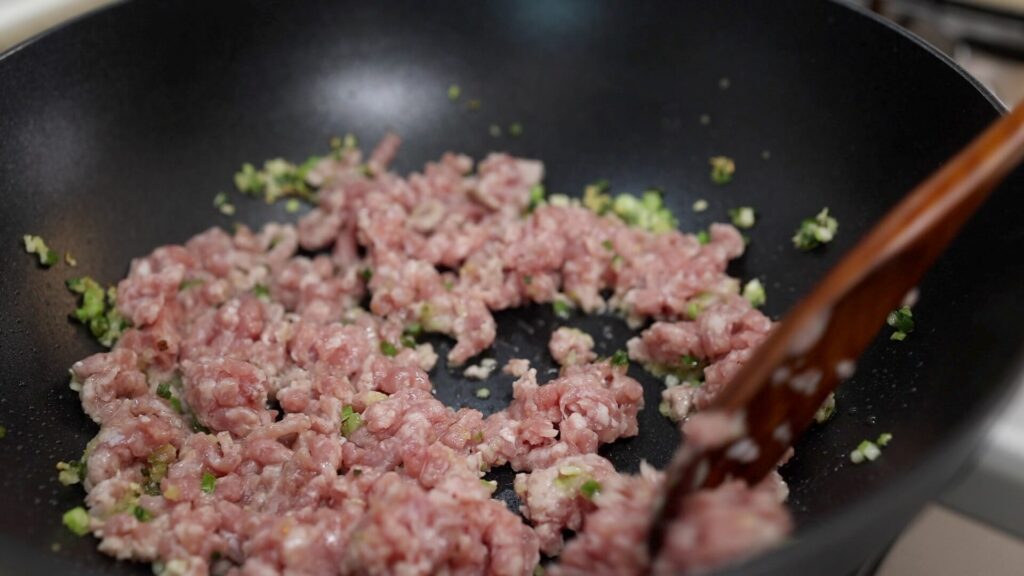
2. Add the ground pork. Break up the pork. Cook for 3 minutes. Add in the sauce. Stir around for 2 to 3 minutes. Once the pork is cooked through, remove it from the heat.
3. Meanwhile, bring a pot of water to a boil. Blanch the bok choy for 1 minute. Take them out and set aside.
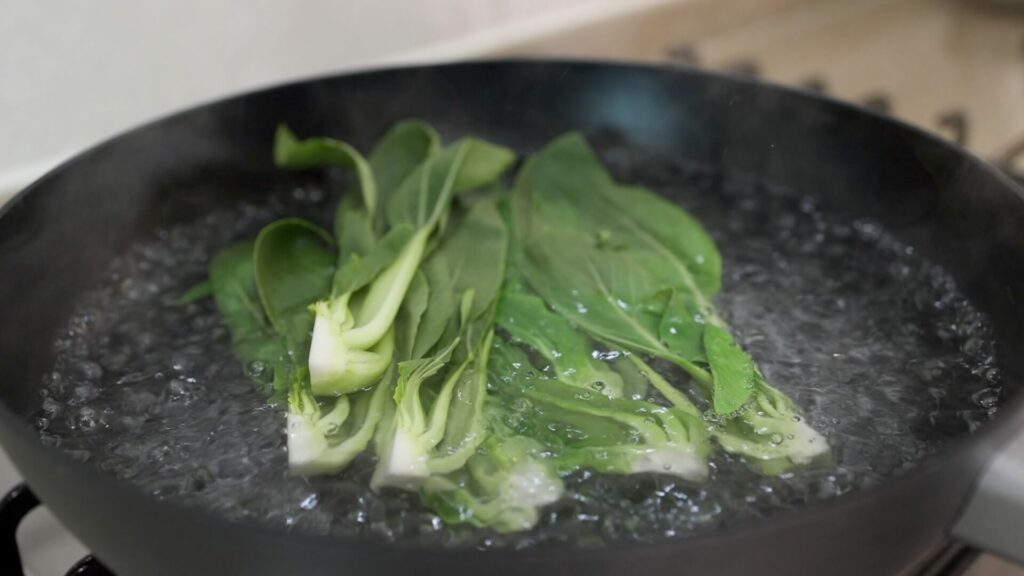
4. In the same water, cook the noodles according to the package instructions. Once they’re done cooking, take them out and shake off the excess water.
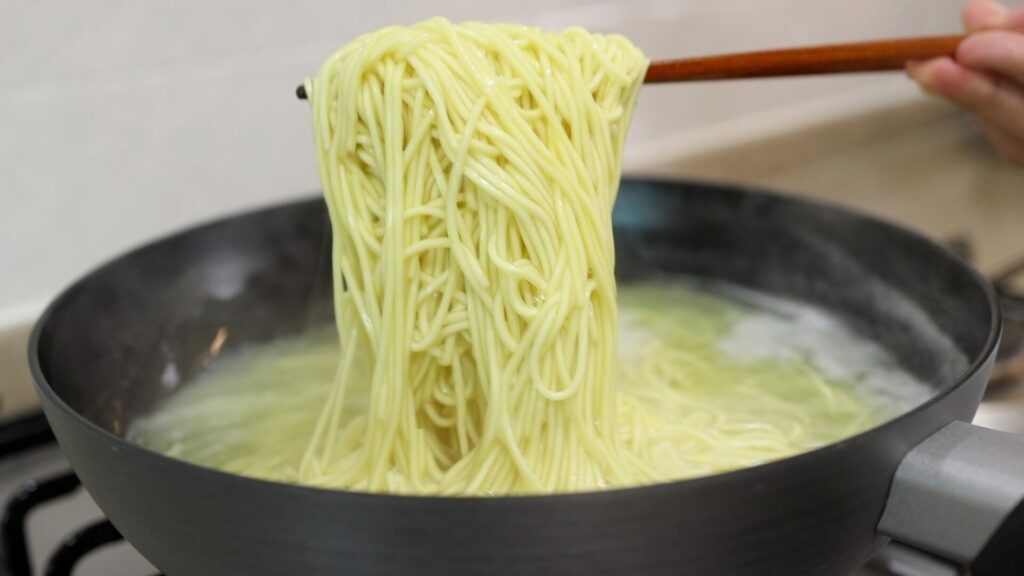
ASSEMBLE
1. In a large mixing bowl, add the drained noodles. Pour the sauce over the noodles. Toss together until they’re completely coated.
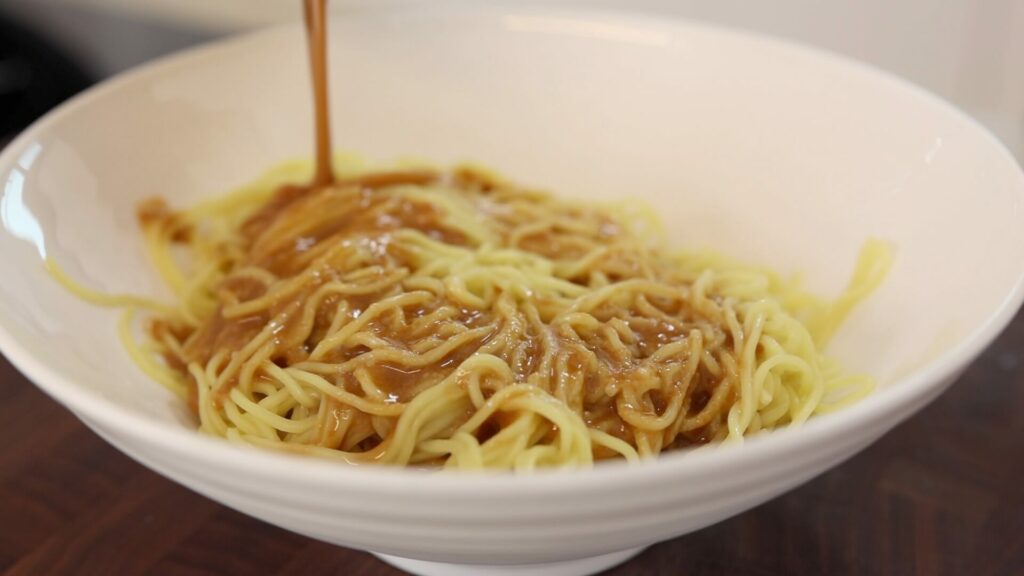
2. Divide the noodles into serving bowls. Add a generous amount of pork topping. Garnish with bok choy, green onion, soft-boiled egg and pickled ginger (if using). Enjoy!
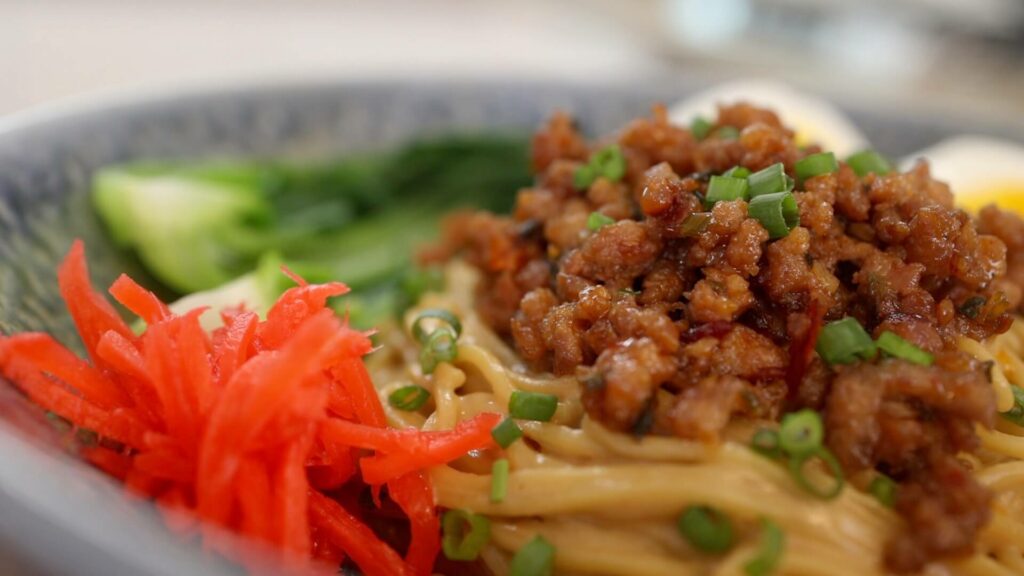
WATCH FULL VIDEO
YOU MAY ALSO LIKE:
- Tantanmen (Tan Tan Ramen)
- Yaki Udon (Japanese Stir Fried Udon Noodles)
- Curry Udon
Ingredients
3 green onions
2 cloves garlic
1 small knob of ginger
2 baby bok choy (or spinach)
2 tbsp neutral-tasting oil
7 oz (200g) ground pork (or ground chicken, chopped mushrooms)
2 servings ramen noodles (or any Asian wheat noodles)
Soft-Boiled Eggs, to garnish
Japanese pickled ginger (beni shoga) (optional), to garnish
- For The Pork:
1 tbsp oyster sauce
1 tsp sugar
1 tbsp mirin
Black pepper, to taste
1/4 tsp Sichuan peppercorn-flavored oil (or 1/2 tsp toasted ground Sichuan peppercorn), (optional)
- For The Noodles:
2.5 tbsp Japanese sesame paste (nerigoma) (can substitute tahini)
2 tbsp soy sauce
1 tbsp white vinegar
1 tsp sugar
1 tbsp mirin
1 tbsp sake
1 tbsp chili oil
1 tbsp toasted sesame oil
1/2 tbsp chicken bouillon powder
1/2 tsp Sichuan peppercorn-flavored oil (optional)
Small pinch of Japanese bonito soup stock powder (hondashi)
1/4 cup (60ml) hot water
Directions
- Prep Vegetables
- Thinly slice the green onions, separating the whites and greens. Finely chop the garlic cloves. Grate a small knob of ginger (1/2 tsp). Cut the bok choy in half (or quarters) lengthwise.
- Make Sauces
- For the meat topping, in a small container, mix together the Chinese chili bean paste, oyster sauce, sugar, mirin, black pepper, and Sichuan peppercorn-flavored oil (if using).
- For the noodles, in another container, mix together the Japanese sesame paste (or tahini), soy sauce, vinegar, sugar, mirin, sake, chili oil, sesame oil, chicken bouillon powder, Sichuan peppercorn-flavored oil (if using), and a pinch of hondashi. (If you’re cooking for your kids, I suggest not using mirin and sake.) To that, add 1/4 cup (60ml) of hot water. Mix to combine.
- Prepare Toppings & Noodles
- In a wok (or pan), heat the oil (2 tbsp) over medium-high heat. Once it gets nice and hot, add the white parts of the green onions, garlic and ginger. Saute for 1 minute or until fragrant.
- Add the ground pork. Break up the pork. Cook for 3 minutes. Add in the sauce. Stir around for 2 to 3 minutes. Once the pork is cooked through, remove it from the heat.
- Meanwhile, bring a pot of water to a boil. Blanch the bok choy for 1 minute. Take them out and set aside.
- In the same water, cook the noodles according to the package instructions. Once they’re done cooking, take them out and shake off the excess water.
- Assemble
- In a large mixing bowl, add the drained noodles. Pour the sauce over the noodles. Toss together until they’re completely coated.
- Divide the noodles into serving bowls. Add a generous amount of pork topping. Garnish with bok choy, green onion, soft-boiled egg and pickled ginger (if using). Enjoy!
Notes
- 1 Tbsp = 15 ml, 1 Cup = 240 ml



